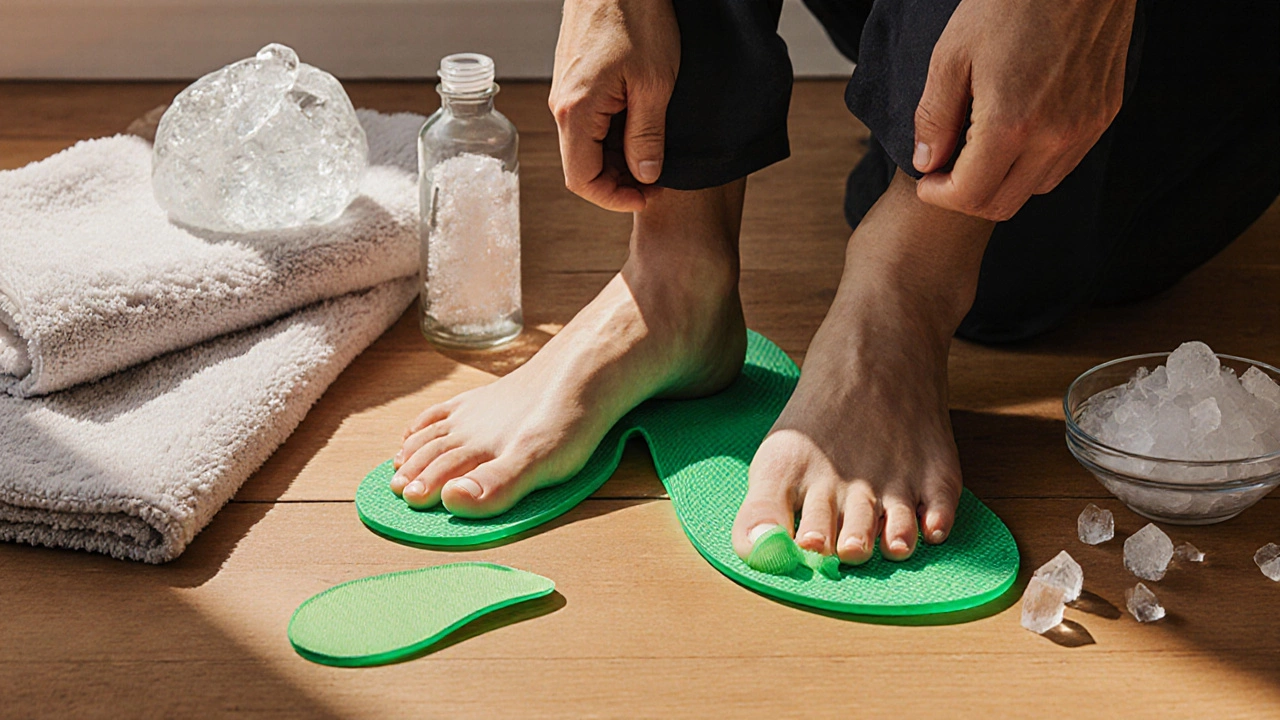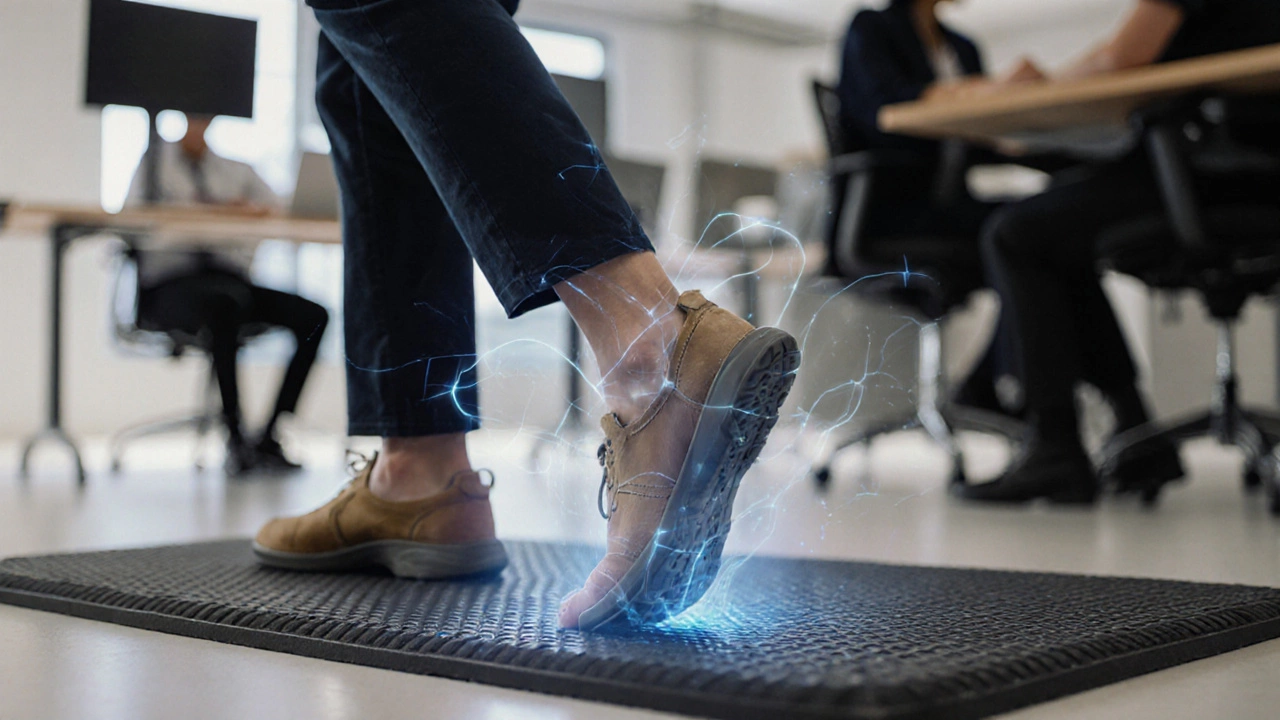How to Survive a 10-Hour Shift on Your Feet: Practical Tips for Work Shoes and Comfort

- Cleo Fairchild
- 20 November 2025
- 0 Comments
Foot Arch Type Quiz
Find Your Foot Arch Type
Your arch type determines the right insoles and shoes for standing all day. Take this quick quiz to discover what you need.
Your Arch Type & Recommendations
Standing for ten hours straight isn’t just tiring-it’s brutal on your body. If you work in retail, healthcare, warehousing, or hospitality, you know the ache in your arches, the burn in your calves, and the dull throb in your lower back by the end of the day. It’s not normal to feel this way. And it’s not something you just have to live with. The right work shoes and a few simple habits can turn a miserable shift into something manageable-even bearable.
Choose work shoes that actually support your feet
Not all shoes labeled "comfortable" are built for all-day standing. Many brands slap on a cushioned insole and call it a day. Real support comes from structure. Look for shoes with three key features: a firm heel counter, a contoured arch support, and a shock-absorbing midsole.Brands like Dansko, Skechers Work, and Clarks have models tested by podiatrists for extended standing. The Dansko Professional clog, for example, has a rocker bottom sole that reduces pressure on your heels and helps your foot roll naturally with each step. That small design detail cuts fatigue by up to 25% according to a 2023 study from the University of Brighton’s biomechanics lab.
Avoid flat sneakers or overly soft foam shoes. They might feel good at first, but they collapse under your weight after a few hours, forcing your tendons and ligaments to compensate. That’s how plantar fasciitis starts.
Use insoles that match your foot type
Even the best work shoes won’t fix a mismatched arch. If you have flat feet, you need firm medial support. If you have high arches, you need extra cushioning under the ball of your foot. Most people don’t know their arch type-so get checked. Many pharmacies and shoe stores now offer free foot scans.Over-the-counter insoles like Superfeet Green or FootActive Sport can make a bigger difference than upgrading your shoes. They’re not cheap-around £30 to £50-but they last 6-12 months and can save you from costly physiotherapy later. Don’t skip this step. A 2024 survey of 1,200 NHS staff found that 78% of those using custom-fit insoles reported less pain by week two.
Stretch before, during, and after your shift
Your feet aren’t the only thing that suffers. Your calves, hamstrings, and lower back tighten up when you stand still for hours. A five-minute stretch routine before your shift can prevent hours of pain afterward.Try these three moves:
- Wall calf stretch: Stand arm’s length from a wall, place one foot back, press the heel down for 30 seconds. Switch sides.
- Toe curls: Sit down, place a towel on the floor, and use your toes to scrunch it toward you. Do 10 reps per foot.
- Seated ankle rolls: Lift one foot off the ground, rotate your ankle clockwise for 15 seconds, then counterclockwise.
Do them during your break, not just before work. Even 90 seconds of stretching every two hours helps. Set a reminder on your phone. It’s not a luxury-it’s maintenance.

Wear moisture-wicking socks, not cotton
Cotton socks hold sweat. Wet feet = blisters. Blisters = canceled shifts. Merino wool or synthetic blends like Coolmax or Dri-FIT pull moisture away from your skin and dry fast. Look for socks with targeted cushioning under the ball and heel.Brands like Smartwool and Thorlos make socks specifically for healthcare and service workers. They cost a bit more than a pack of cotton socks, but they last longer and reduce friction-related injuries. One nurse in Manchester switched to merino wool socks after three years of daily blisters-and hasn’t had one since.
Move your body, even if you’re "standing still"
Standing still is worse than walking. Your muscles lock up. Blood pools in your legs. You’re more likely to get swollen ankles or varicose veins.Shift your weight. Rock from heel to toe. Shift your stance every 10 minutes. If you’re at a register, balance on one foot for 30 seconds, then switch. Do small calf raises while waiting for customers. These micro-movements keep your circulation flowing and stop your muscles from going numb.
A 2023 study in the Journal of Occupational Health found that workers who made small, frequent posture changes reported 40% less lower back pain than those who stayed rigid.
Use anti-fatigue mats if you can
If your workplace lets you choose where you stand, ask for an anti-fatigue mat. These aren’t just for factories. Retail stores, pharmacies, and kitchens are starting to use them too. They’re made of dense, springy rubber that gives slightly under your weight-reducing pressure on your joints.Look for mats with beveled edges to prevent tripping and a non-slip surface. A 24" x 36" mat costs around £40-£70 and lasts years. If your employer won’t provide one, buy it yourself. It’s cheaper than a podiatrist visit.

Hydrate and eat smart
Dehydration makes muscles cramp and joints stiffen. Drink water consistently-not just when you’re thirsty. Aim for 2-3 liters during your shift. Avoid sugary drinks and caffeine-heavy energy drinks. They cause blood sugar spikes and crashes, leaving you more tired.Snack on protein and complex carbs: nuts, hard-boiled eggs, Greek yogurt, or whole grain crackers. These give steady energy without the crash. Skip the candy bar. It’ll make you feel worse by mid-shift.
Recover properly after your shift
Your feet don’t magically heal overnight. Post-shift care matters as much as what you wear during work.At home, elevate your feet above heart level for 15-20 minutes. Use a footrest or stack of pillows. Then, roll a frozen water bottle under your arch for 5 minutes. The cold reduces inflammation, and the rolling massages your plantar fascia.
Try a 10-minute foot soak with Epsom salts. It’s simple, cheap, and helps relax tight muscles. Don’t skip this. People who do it regularly report fewer morning pains and better sleep.
Know when to speak up
If you’re in pain that doesn’t go away after a few days off, see a professional. Don’t wait until you can’t walk. Chronic foot pain can lead to knee or hip problems. In the UK, you can get a referral to a physiotherapist through your GP-or book a private appointment with a chartered physio or podiatrist.Some employers are required under the Health and Safety at Work Act to provide ergonomic support if your job involves prolonged standing. You have rights. Document your pain, track your symptoms, and ask for adjustments. You’re not being lazy-you’re being smart.
Surviving a 10-hour shift on your feet isn’t about gritting your teeth. It’s about using the right tools, making small changes, and respecting your body. The right work shoes, the right socks, the right stretches, and the right habits don’t just make your shift easier-they keep you working for years to come.


